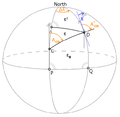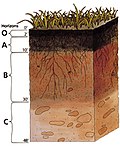Geography
Geography (from Greek: γεωγραφία, geographia, literally "earth description")[1] is the study of earth and its people and one of social sciences.[2] Its features are things like continents, seas, rivers and mountains. Its inhabitants are all the people and animals that live on it. Its phenomena are the things that happen like tides, hurricanes, tornadoes, earthquakes and more.
A person who is an expert in geography is a geographer. A geographer tries to understand the world and the things that are in it, how they started and how they have changed.[3]
Geography is divided into two main parts which are: Physical geography and human geography. Physical geography studies the natural environment and human geography studies the human environment. The human environmental studies would include things such as the population in a country, how a country's economy is doing, and more. There is also environmental geography.
Maps are a main tool of geography, so geographers spend much time making and studying them. Making maps is called cartography, and people who specialize in making maps are cartographers.
Branches
Physical geography
Physical geography (or physiography) focuses on geography as an Earth science. It aims to understand the physical problems and the issues of lithosphere, hydrosphere, atmosphere, pedosphere, and global flora and fauna patterns (biosphere).
Physical geography can be divided into many broad categories, including:
Human geography
Human geography is the social science that covers the study of people and their communities, cultures, economies and their interaction with the environment. Geographers studying the human environment may look at:
History
The oldest known world map dates back to ancient Babylon from the 9th century BC.[4] The best known Babylonian world map is the Imago Mundi of 600 BC.[5] Star charts (maps of the sky) are of similar age.
During the Middle Ages, people in Europe made fewer maps. People in the eastern countries made more.[6] Abū Zayd al-Balkhī created the "Balkhī school" of mapping in Baghdad.[7]
Western Europe became known as the leader of geographic thought during the European Renaissance and The Age of Exploration (1400–1600). The printing press made maps and information about the world available to everyone. In 1650, the first edition of Geographia Generalis was published.
In the 1700s and 1800s scientists started to study the relationship between the environment and its people
Related pages
Geography Media
Maps, like this 17th Century depiction of Pembrokeshire, are a central element in the study of geography.
A right-handed three-dimensional Cartesian coordinate system used to indicate positions in space
Examples of the visual language of time geography: space-time cube, path, prism, bundle, and other concepts.
Map of Earth showing both physical features and political boundaries from the 2023 CIA World Factbook
James Cook's 1770 chart of New Zealand
Synthetic aperture radar image of Death Valley colored using polarimetry
A compound chorochromatic map of Indo-Aryan (Indic) languages
Etching of an ancient seal identified as Eratosthenes. Philipp Daniel Lippert, Dactyliothec, 1767.
References
- ↑ Harper, Douglas. "Online Etymology Dictionary". Etymonline.com. Online Etymology Dictionary. Archived from the original on 12 February 2009.
- ↑ "Geography". The American Heritage Dictionary/ of the English Language, Fourth Edition. Houghton Mifflin Company. Retrieved October 9, 2006.
- ↑ Geography: The Mother of Sciences [1] [2]
- ↑ Kurt A. Raaflaub & Richard J.A. Talbert (2009). Geography and Ethnography: Perceptions of the World in Pre-Modern Societies. John Wiley & Sons. p. 147. ISBN 978-1-4051-9146-3.
- ↑ Siebold, Jim. "Slide 103". henry-davis.com. Henry Davis Consulting Inc. Archived from the original on 29 September 2018. Retrieved 10 November 2016.
- ↑ Needham, Joseph (1959). Mathematics and the Sciences of the Heavens and the Earth. Science and Civilization in China. Vol. 3. Taipei: Caves Books, Ltd. p. 512. ISBN 978-0-521-05801-8. Retrieved 10 November 2016.
- ↑ Edson, Evelyn; Savage-Smith, Emilie (Winter 2007). "Medieval Views of the Cosmos". International Journal of the Classical Tradition. 13 (3): 61–63. JSTOR 30222166.
Other websites
- Geography Trainer 1.3 - Educational game aimed at school children Archived 2021-02-23 at the Wayback Machine
- www.geoknow.net - Geography resources at your fingertips!
- PopulationData.net Archived 2008-09-10 at the Wayback Machine
- PopulationMondiale.com Archived 2011-02-10 at the Wayback Machine
- Using Literature To Teach Geography in High Schools. ERIC Digest. Archived 2015-03-08 at the Wayback Machine
- Teaching Geography at School and Home. ERIC Digest. Archived 2015-04-26 at the Wayback Machine
- The National Geography Content Standards. ERIC Digest. Archived 2015-04-26 at the Wayback Machine





















